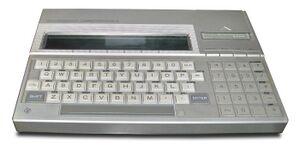Engineering:Texas Instruments Compact Computer 40
 | |
| Type | Portable computer |
|---|---|
| Release date | Script error: No such module "Date time". |
| Introductory price | US$249 (equivalent to $786.1 in 2024) |
| CPU | TMS70C20 @ 2.5 MHz |
| Memory | 6 KB |
The Texas Instruments Compact Computer 40 or CC-40 is a battery-operated portable computer developed by Texas Instruments and released in March 1983. Priced at US$249, it weighs 600 grams (22 ounces) and can be powered by four AA batteries or an AC adapter. It was intended as a portable business computer, and uses TI's TMS70C20 CPU, an 8-bit microprocessor that runs at 2.5 MHz.
The CC-40 has 6 kilobytes of on board Random Access Memory (expandable to 18 KB), 34 KB of Read Only Memory, and a 31-character LCD display. It is capable of operating for 200 hours off one set of batteries, and memory is not erased by powering the unit off, so an unpowered unit can retain data for several months.
The CC-40 has a single Hexbus port for connecting peripherals. The following Hexbus peripherals were released: 80 column printer, printer/plotter, RS232, and modem. A digital "wafertape" unit (a licensed version of the Exatron Stringy Floppy)[1] depicted on the computer's box was only released as a prototype, reportedly because it proved too unreliable. The inability to store data permanently hurt the CC-40's sales.
Software was only available on cartridge or by typing programs into its built-in BASIC interpreter. The BASIC interpreter is similar but not identical to the Texas Instruments TI-99/4A.
Reception
BYTE heavily criticized the CC-40; "there's no clock. No file system. Only one BASIC program at a time can reside in memory, and the user can only work with about 5200 bytes of that. And the keyboard is vile". It also noted the lack of any external storage because the TI wafertape drive was not available, and the complete lack of software. The review suggested that the computer should be considered a "dandy scientific calculator" since good programmable calculators cost about the same as the CC-40's $250 price, but that otherwise "virtually all of its competition vastly outstrips it in power and features", including the $99 TI-99/4A.[2]
In a review for Creative Computing, Joe Devlin wrote, "The permanent memory and powerful Basic exceed the capabilities found in most hand-held computers."[3] He recommended it as a convenient tool for learning BASIC or for someone who frequently does calculations with formulas.[3]
In 1983, MicroKids magazine included the CC-40 on a list of "Top 10 Great Gift Ideas."[4]
Legacy

The Hex-Bus interface was also available for the TI-99/4A as an unreleased prototype expansion peripheral. It was built into the prototypes of the cancelled TI-99/2 and TI-99/8 computers.
An improved model, the CC-40 Plus, was in the final stages of development and included a cassette port. The project was canceled when Texas Instruments discontinued the 99/4A and left the home computer field.
Also in development was the Compact Computer 70. The CC-70 was to have four cartridge ports, more RAM, and an 8 x 80 display with graphics capability. Some of the work completed on the CC-70 was later revived in the TI-74 Basicalc.[citation needed]
References
- ↑ Halfhill, Tom R. (July 1983). "Exatron Stringy Floppy for VIC-20 and 64". Compute!'s Gazette: pp. 58–62. https://archive.org/stream/1983-07-computegazette/Compute_Gazette_Issue_01_1983_Jul#page/n59/mode/2up. Retrieved 6 February 2016.
- ↑ Ramsey, David (September 1983). "Epson's HX-20 and Texas Instruments' CC-40". BYTE: pp. 193. https://archive.org/stream/byte-magazine-1983-09/1983_09_BYTE_08-09_Portable_Computers_in_Depth#page/n201/mode/2up. Retrieved 20 October 2013.
- ↑ 3.0 3.1 Devlin, Joe (August 1983). "Texas Instruments CC-40". Creative Computing: 37–43. https://archive.org/details/Creative_Computing_1983-08/page/n39.
- ↑ Kuhn, Paul (December 1983). "Top 10 Great Gift Ideas". MicroKids 1 (1): 60. https://archive.org/details/MicroKids_Issue_01_Volume_01_No_01_1983-12_Microkids_Publishing_US/page/n61.
- Thomas, David (1983). Learn BASIC: A Guide to Programming the Texas Instruments Compact Computer 40. Texas Instruments, Inc. and McGraw Hill, Inc. ISBN 0-07-064257-5.
External links
- A special page of a Casio fan about CC-40 computer
- 99er page on the CC-40
- OLD-COMPUTERS.COM online-museum CC-40 page
- Curtis McCain Page on the CC-40
